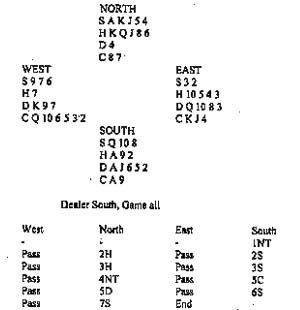|
Bridge
David Bird
 North’s
2H showed at least five spades. 3H showed a second suit and was forcing
to game. South’s 3S was therefore a stronger bid than 4S. Roman
Key-card Blackwood located three aces in the South hand and the 5D
follow-up asked about the trump queen. 6S said ‘Yes, I have the trump
queen but no side-suit king.’ North then bid the grand. How would you
have played 7S on a trump lead? Declarer won in the South hand, cahsed
the diamond ace, and ruffed a diamond. He then overtook the spade jack
with the queen and ruffed another diamond. A heart to the ace permitted
a third diamond ruff with the bare ace. Declarer returned to the ace of
clubs and drew the last trump. Dummy’s hearts then provided enough
tricks for the contract. It was a fine example of the dummy reversal.
Does anything else strike you? A heart or club lead would have beaten
the grand! Both leads remove a key entry from the South hand. North’s
2H showed at least five spades. 3H showed a second suit and was forcing
to game. South’s 3S was therefore a stronger bid than 4S. Roman
Key-card Blackwood located three aces in the South hand and the 5D
follow-up asked about the trump queen. 6S said ‘Yes, I have the trump
queen but no side-suit king.’ North then bid the grand. How would you
have played 7S on a trump lead? Declarer won in the South hand, cahsed
the diamond ace, and ruffed a diamond. He then overtook the spade jack
with the queen and ruffed another diamond. A heart to the ace permitted
a third diamond ruff with the bare ace. Declarer returned to the ace of
clubs and drew the last trump. Dummy’s hearts then provided enough
tricks for the contract. It was a fine example of the dummy reversal.
Does anything else strike you? A heart or club lead would have beaten
the grand! Both leads remove a key entry from the South hand.
What would you say now?
 Answer Answer
Hands like this are
always difficult to bid without playing any conventions. You are too
strong for a limit raise to 3C, which would show about 9-11 points. Nor
is it attractive to bid 2NT or 3NT when you hold only a low doubleton in
hearts. The best idea is to ‘invent’ a response of 1D and wait to
hear further information from partner. Some players use ‘inverted
raises’. This means that a raise to 2C would be forcing; a raise to 3C
would show a weaker hand and be non-forcing. Awards: 1D-10, 2NT or
3NT-6, 3C-5.
— Knight Features
|